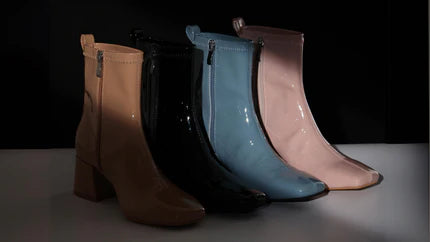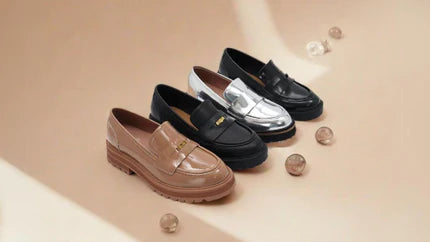Heeled boots can turn heads and add a dash of style to your outfit, but walking in them isn't always easy. In this guide, we'll talk about how the way you walk and things like wet or uneven ground can change how comfortable your boots are. If you’ve got wide feet, we’ve got tips on what to watch out for so you can rock those stylish boots without any pinches or pain.
What You Need to Know About Heeled Boots
Heeled boots are any type of boot that features a raised heel, which can vary widely in height and shape, setting the foundation for the boot's style and comfort level.
What Kinds of Heeled Boots Are There?
- Ankle Boots: These hit around your ankle and are easy to pair with jeans or dresses.
- Calf-Length Boots: These stop between your ankle and knee. They’re versatile for different seasons and outfits.
- Knee-High Boots: They reach up to your knees and are great for colder weather or making a fashion statement.
- Stiletto Heels: Also known as stilettos, they're very high and skinny, giving you a lot of height but can be hard to balance.
- Block Heels: These boots have a thicker heel that's easier on your feet, making them comfortable enough to wear more often.
- Wedge Heels: The heels are thick and run along the entire bottom of the boot, so they give height but are easier to walk in than thin heels.
What to Look For in a Great Pair of Heeled Boots:
- Heel Height: The taller the heel, the more challenging it might be to walk. Heel height impacts how your foot is angled and can affect your balance.
- Sole Design: The bottom part of your boot needs to have good traction to prevent slipping, and it should complement the heel design for stability.
- Material Flexibility: The material of your boots should have enough give to allow natural movement of your feet as you walk.
- Toe Shape: From pointed to round to square, the shape of the toe can impact how your toes feel throughout the day. A roomier toe box usually means more comfort.
- Arch Support: Good arch support is essential for comfort, especially when wearing heels, as it helps distribute weight more evenly.
- Cushioning: Adequate padding underfoot can absorb shock and reduce the strain on your feet, making it easier to wear the boots for longer periods of time.
Whether you’re strutting down the office hallway or stepping out for an evening event, picking the perfect pair is about balancing fashion with thoughtful features that support your feet every step of the way.

What Makes Traditional Heeled Boots Hard to Walk In?
Walking in heeled boots isn’t always a walk in the park, and there are a few reasons why. Let’s look at what can make wearing these stylish shoes a bit tricky sometimes.
How Your Feet and Walking Style Affect the Comfort
- Foot Shape: Just like people, feet come in all shapes and sizes. A boot that fits your friend well might not be right for you if it squeezes your toes or rubs against your heel.
- Walking Style: The way you walk naturally could also make heels feel odd. If you tend to stomp or your feet roll in or out when you step, heels might seem harder to balance in.
- Tired Toes: Heels put more pressure on the front part of your foot, which can lead to sore toes fast, especially if there's not much room for them or if the boots aren't padded enough.
How Location and Timing Impact the Comfort
- Where You Walk: Different grounds call for different walks. Slick floors indoors can send your heels sliding, and stepping on uneven paths like cobblestones or gravel outside can make your heels unstable.
- Weather Woes: Then there’s the weather—rain makes things slippery, snow hides bumps and holes, and ice can turn sidewalks into slides. These conditions make it extra important to think about when and where to rock those heeled boots.
Choose a pair that feels good on your unique feet and suits your walk. Keep an eye on the ground and the sky before you step out. This way, you'll be comfy and look sharp, whether you're on a smooth dance floor or braving the cobblestones on a rainy day.
Can Heeled Boots Be Comfortable?
Absolutely, heeled boots can be quite comfortable. Here’s what to look out for:
Look for Natural Materials Like Real Leather
Leather is a go-to because it adapts over time, stretching slightly to mold to the contours of your feet. This natural give ensures that your boots will become more comfortable with each wear.
Prioritize Non-Slip Soles
Stability is paramount, so select boots with soles designed for traction. Rubber grips can handle slick surfaces, offering peace of mind as you move.
Don't Skimp on Insole Quality
Quality insoles matter. Look for boots with thick cushioning and proper arch support, distributing weight evenly and reducing foot fatigue. Removable insoles are a plus, giving you the flexibility to customize the boot's fit or add orthotics if needed.
Select a Supportive Heel Structure
A robust heel can make all the difference, ensuring that your body weight is not leaning forward onto your toes. This balance is essential for a more natural and confident walking experience.
Choose a Spacious Toe Box
A roomy toe box is crucial for the comfort of your feet. It allows your toes the freedom to spread out, preventing cramping and overcrowding, which can lead to discomfort or even pain throughout the day.
Ensure Proper Ventilation
A breathable interior is key to keeping your feet dry and cool. Moisture-wicking materials or designs that promote air circulation prevent sweaty feet and reduce the risk of blisters.

Opt for Elastic Features or Zippers
Boots with elasticated panels or side zippers cater to your feet by providing extra give, making them easier to slip on and off. These features also accommodate foot expansion throughout the day.
Find a Brand That Caters to Your Feet
At Wydr Studios, we know it's tough to find heeled boots that don't hurt your feet. That's why we've dedicated our line to include sizes and widths that celebrate broader, thicker feet, plus generous room for a larger ball girth. We aim to ensure that when you slide into our boots, they fit like they were made just for you—because they are. Comfortable and perfect for anyone who's ever felt squeezed in by standard sizes; that's the Wydr way.
The Takeaway
Picking out the right heeled boots can be simple, even if you have wide feet or need extra comfort. Keep an eye out for boots with plenty of toe room, made from materials that feel good, and include features for steady walking. Think about what works for your own feet and how you walk. And don't forget to consider where you'll be walking and the weather. With these tips in mind, you can choose boots that look great and won't give your feet a hard time.
FAQs About Heeled Boots
Q1: Can Heeled Boots Be Comfortable for Your Feet?
Heeled boots can be comfortable if they're made well and have the right features. Look for heeled boots with space for your toes, cushioned insides, and solid heels that keep you stable. Good ones will support your feet and won’t make you slip.
Q2: What Types of Heels Offer the Most Stability?
Chunky heels offer the most stability because they have a larger base, which means better balance and less wobble when you walk. Low to medium heel heights also tend to be more stable compared to sky-high heels.
Q3: Is it OK to wear heeled boots daily?
Wearing heeled boots every day might not be the best idea. If you love your heels, try to limit how often you wear them, mix up the heel heights, and choose designs with good support and cushioning.



